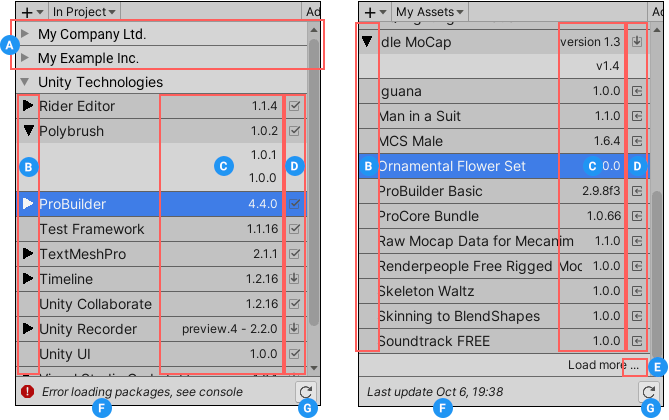List view
The Package Manager window displays the list of packages or Asset StoreA growing library of free and commercial assets created by Unity and members of the community. Offers a wide variety of assets, from textures, models and animations to whole project examples, tutorials and Editor extensions. More info
See in Glossary packages according to the criteria that you select by filtering or searching:

(A) Registry groups organize the list of packages installed in your project (or available for installation when you are in the My Registries context). Select the expander on the left to show or hide the list of packages for each registry.
(B) Select these expander icons to show and hide the list of versions installed or available.
(C) The package version displays the version of the package that’s installed. If the package is not yet installed, the version that appears is the recommended version.
For Asset Store packages, the version that appears is either the version you already downloaded or the version that is available for download from the Asset Store.
(D) These icons display the status of the package or Asset Store package:
| Icon: | Description |
|---|---|
 |
A check mark indicates that the package is already installed or enabled. Note: Installed Asset Store packages do not display an icon if they are up to date. |
| The download icon indicates that the package has an available update. To update your package, follow the instructions for either type of package: - For Unity packages, see Switching to another package version. - For Asset Store packages, see Updating your Asset Store package. |
|
| The import icon indicates that there is an Asset Store package available to import. | |
 |
An error icon indicates that something went wrong during installation or loading. For more advice on resolving errors, see Error messages. |
(E) By default, the My Assets context displays only one page of Asset Store packages available. To load the rest of the Asset Store packages, click the Load more … link.
Note: If you select the My Assets context but you don’t see any packages, see Error messages in the Package Manager window for an explanation and solution.
(F) The status bar displays messages about the package load status and network warnings.
(G) Click the reload  button to force Package Manager to reload your packages.
button to force Package Manager to reload your packages.
By default, the Package Manager window displays the list of all packages available on the Unity Registry, but you can filter the list to display packages matching a specific context.
You can also include preview packages in the list and search for a specific package by package name or display name.
Including Preview packages
Preview packages do not appear by default in the list of packages on the Package Manager window. This is because preview packagesA preview package is in development and not yet ready for production. A package in preview might be at any stage of development, from the initial stages to near completion.
See in Glossary might be unstable, so you should not use them in production.
To include preview packages in the list, select Show preview packages from the Advanced drop-down menu.
